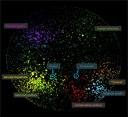
Mapping Iran’s Online Public: Politics and Culture in the Persian Blogosphere
(English and Persian translation)
 Update: "Mapping Iran's Online Public" is now available in Persian: Download PDF (Persian). You can find the interactive Persian blogosphere map here.
Update: "Mapping Iran's Online Public" is now available in Persian: Download PDF (Persian). You can find the interactive Persian blogosphere map here.
This case study is part of a series produced by the Internet and Democracy project. The initial studies include three of the most frequently cited examples of the Internet’s influence on democracy. The first case looks at the user-generated news site, OhmyNews, and its impact on the 2002 Presidential elections in South Korea. The second documents nontraditional media and the use of cell phone technologies for information sharing and organization of protesters during Ukraine’s Orange Revolution. This third case analyzes the composition of the Iranian blogosphere and its possible impact on political and democratic processes. The objectives of these studies are to write a narrative description of the events and the technology used in each case, to draw initial conclusions about the actual impact of technology on democratic events and processes, and to identify questions for further research.
Abstract
We
used computational social network mapping in combination with human and
automated content analysis to analyze the Iranian blogosphere. In contrast to
the conventional wisdom that Iranian bloggers are mainly young democrats
critical of the regime, we found a wide range of opinions representing
religious conservative points of view as well as secular and reform-minded
ones, and topics ranging from politics and human rights to poetry, religion,
and pop culture. Our research indicates that the Persian blogosphere is indeed
a large discussion space of approximately 60,000 routinely updated blogs
featuring a rich and varied mix of bloggers. Social network analysis reveals
the Iranian blogosphere to be dominated by four major network formations, or poles,
with identifiable sub-clusters of bloggers within those poles. We label the poles as 1) Secular/Reformist, 2) Conservative/Religious,
3) Persian Poetry and Literature, and
4) Mixed Networks. (View the full map / view the full map in Persian / explore the updated, interactive map.) The secular/reformistpole contains both expatriates and Iranians involved in a dialog about Iranian
politics, among many other issues. The conservative/religiouspole contains three distinct sub-clusters, two focused principally on religious
issues and one on politics and current affairs. Given the repressive political
and media environment, and high profile arrests and harassment of bloggers, one
might not expect to find much political contestation in the blogosphere. However, we identified a subset of the secular/reformist pole focused intently
on politics and current affairs and comprised mainly of bloggers living inside
Iran, which is linked in contentious dialog with the conservative political
sub-cluster. Surprisingly, a minority of
bloggers in the secular/reformistpole appear to blog anonymously, even in the more politically-oriented part of
it; instead, it is more common for bloggers in the religious/conservative pole
to blog anonymously. Blocking of blogs by the government is less pervasive than
we had assumed. Most of the blogosphere
network is visible inside Iran, although the most frequently blocked blogs are
clearly those in the secular/reformistpole. Given the repressive media
environment in Iran today, blogs may represent the most open public
communications platform for political discourse. The peer-to-peer architecture of the
blogosphere is more resistant to capture or control by the state than the older,
hub and spoke architecture of the mass media model.

